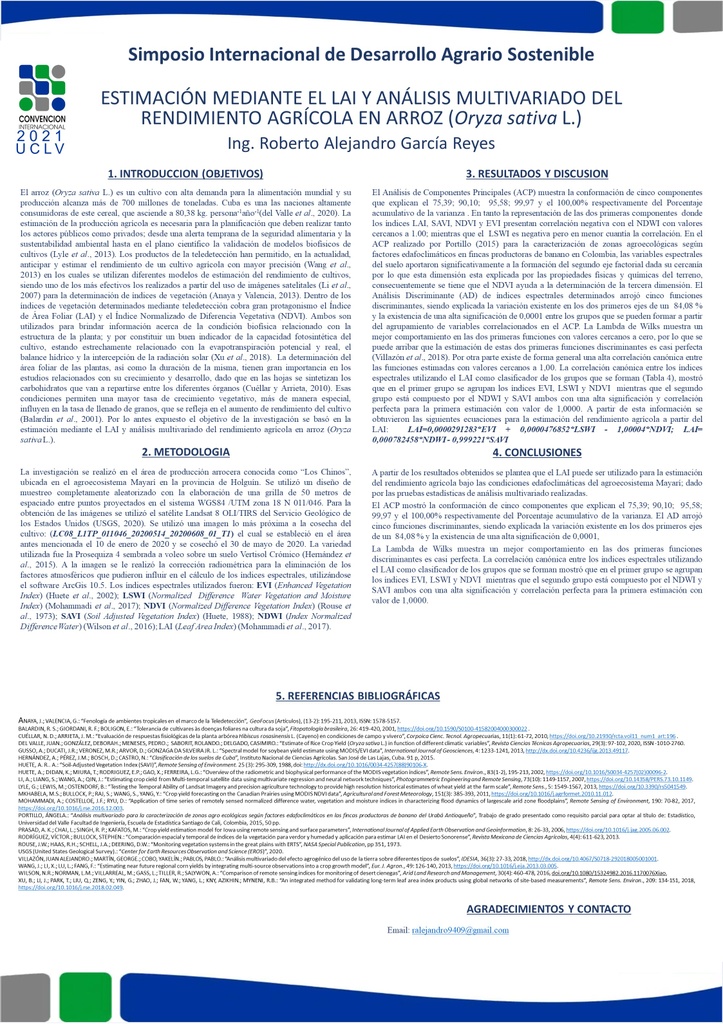Executive Secretary

10th International Scientific Conference on Agricultural Development and SustainabilityAGROCENTRO 2023
Agrocentro 2021

Abstract
Remote sensing makes it possible monitoring the agricultural yield of crops, based on spectral indices related to the state of vegetation, water and soil. The objective of this research was the estimation by means of the LAI and multivariate analysis of the agricultural yield of rice. The production area “Los Chinos” is located in the Mayarí agroecosystem, Holguín province. An image belonging to Landsat 8 OLI / TIRS was taken. 50 random points were drawn from which the values in the corrected image of the spectral indices were extracted: NDVI, SAVI, NDWI, LAI, EVI and LSWI. The ACP showed the conformation of five components that explain the 75.39; 90.10; 95.58; 99.97 and 100.00% of the variance respectively. The AD of determined spectral indices yielded five discriminant functions, explaining the variation in the first two axes of 84.08% and the existence of high significance (p <0.0001) between the groups that can be formed from of the grouping of correlated variables in the PCA. Wilks' Lambda shows better behavior in the first two functions with values close to zero, so the estimation of these first two discriminant functions is almost perfect. In general, there is a high canonical correlation between the estimated functions with values close to 1. It is concluded that from the LAI and the multivariate analysis, two functions are obtained that have high reliability for estimating agricultural yield in rice cultivation in the edaphoclimatic conditions studied.
Resumen
La teledetección permite monitorear el rendimiento agrícola de los cultivos, a partir de índices espectrales relacionados con el estado de la vegetación, agua y suelo. La investigación tuvo como objetivo la estimación mediante el LAI y análisis multivariado del rendimiento agrícola en arroz. El área de producción “Los Chinos” está ubicada en el agroecosistema Mayarí, provincia Holguín. Se tomó una imagen perteneciente al Landsat 8 OLI/TIRS. Se trazaron 50 puntos aleatorios a los cuales se les extrajeron los valores en la imagen corregida de los índices espectrales: NDVI, SAVI, NDWI, LAI, EVI y LSWI. El ACP mostró la conformación de cinco componentes que explican el 75,39; 90,10; 95,58; 99,97 y el 100,00% respectivamente de la varianza. El AD de índices espectrales determinados arrojó cinco funciones discriminantes, siendo explicada la variación existente en los dos primeros ejes de un 84,08 % y la existencia de una alta significación de 0,0001 entre los grupos que se pueden formar a partir del agrupamiento de variables correlacionados en el ACP. La Lambda de Wilks muestra un mejor comportamiento en las dos primeras funciones con valores cercanos a cero, por lo que la estimación de estas dos primeras funciones discriminantes es casi perfecta. Existe de forma general una alta correlación canónica entre las funciones estimadas con valores cercanos a 1,00. Se concluye que a partir del LAI y el análisis multivariado se obtiene dos funciones que tiene una confiabilidad para la estimación del rendimiento agrícola en el cultivo del arroz en las condiciones edafoclimáticas estudiadas.
About The Speaker

Prof. Roberto Alejandro García Reyes

Discussion

